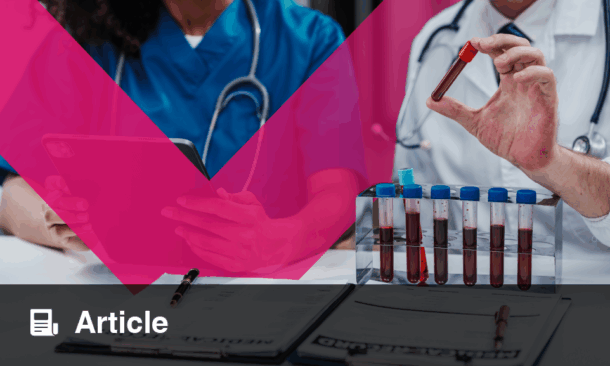Joshua Richter | Associate Professor, Tisch Cancer Institute, Icahn School of Medicine at Mount Sinai, New York, USA
Citation: EMJ Hematol. 2025;13[1]:79-81 https://doi.org/10.33590/emjhematol/GGDY7274
![]()
What initially inspired your journey into medicine, and what motivated your specialisation in haematology and oncology, particularly within the plasma cell disorders field?
I knew from a very young age that I was interested in medicine and science. As an undergraduate, I ended up majoring in psychology and minoring in philosophy, where I became fascinated by not just medicine, but also by ethics and end-of-life care ethics. We can really help people live full and complete lives. We can help them through the good and the bad and develop important relationships with them and for some we can “functionally cure”. It is wonderful to visit a doctor with a problem, have them evaluate you and give you a therapy that they did not discover, invent, or optimise, and then become cured.
There’s also something wonderful about helping people even when there is no cure, going through the good times and the bad times and trying to help them live normal lives despite the disease.When I was training, this was a major inflexion point for myeloma. If you look at the therapies and the outcomes before I started practising, it was dismal. Now, however, it’s amazing. Some of my early mentors, people like Madhav Dhodapkar, Fred Hutchinson Cancer Center, Washington, USA, and Sundar Jagannath, Mount Sinai, New York, USA, were trying to cure patients when everyone was saying that it wasn’t possible. There’s a common expression, “hold my beer”, that in this instance boils down to: we don’t care about what you’re saying, and we’re going to find a way to cure it, understand it, and get inside of it.
In my opinion, one of the greatest things you can do is be part of a global effort to take a disease from being fatal and incurable to one that people can recover from and live their lives without. I’m hoping that by the time I retire, we’ll be able to cure everyone. It’s an amazing thing to be part of.
With your focus on multifunctional antibodies, what are the primary challenges you face in applying these therapies to multiple myeloma, and how is your team addressing them?
Medicine is like the story of Goldilocks and the Three Bears. You never want things too hot, too cold, or too extreme one way or the other. It’s the same idea for bispecific and trispecific antibodies. We don’t want your immune system to be too weak, where it’s not fighting the cancer, but we also don’t want it to be so active to the point where you’re having side effects.
When you first administer these drugs, they can cause the immune system to become overactive. At academic centres, we have a lot of expertise in that, but community doctors don’t, and 80% of myeloma in the USA is treated in the community. The reality is that this doesn’t have to be an all or none situation. We can share responsibility; we can work together. You might ask why a patient should travel two hours to see me if they only need to travel for five minutes to see their primary oncologist. The answer is that, if you are being treated by a doctor in the community that doesn’t have the inpatient facilities or the expertise to administer the initial dose with those toxicities, then I can and will take care of the patient for a fixed period of time and get them over that initial issue. Once things have settled down, the patient can go back to their local physician, and the primary oncologist and I can work together. Patients don’t have to only be treated locally or only be treated by me; instead, we can all work together to provide patients with every possible option and reduce the negative impact on their quality of life.
Precision medicine is central to your work in myeloma. How do you envision its evolution over the next five years, particularly regarding patient stratification and tailoring treatment approaches?
In many ways, lymphoma is quite far ahead of us. There are so many different types of lymphoma, such as diffuse large B cell lymphoma and chronic lymphocytic leukaemia. We joked in the past, when the primary treatment for lymphoma was R-CHOP (a combination of rituximab, cyclophosphamide, doxorubicin, vincristine, and prednisolone), that lymphoma was 100 diseases with one treatment and myeloma was one disease with 100 treatments. This isn’t true anymore, because they administer different treatments for lymphoma. When we diagnose patients, we take a snapshot of how we think it will behave, but we don’t fully know how it will act until we start treating it. We give them all the same therapy, and sometimes it works better than expected, while other times it doesn’t.
I’m hoping that, with the evolution of precision medicine, myeloma becomes more like a urinary tract infection. If someone has a urinary tract infection, they pee in a cup, they place the urine on agar disks and then put little tablets of antibiotics so as the bacteria grows we know which antibiotic kills it I want the future of myeloma to be like this: the patient is sequenced, we know what drugs they need, and they don’t need a transplant. Instead of feeling our way around in the dark, we can turn the light on and tell them exactly what type of myeloma they have and what treatment is needed. The future is about personalised treatment.
Resistance to bispecific antibodies remains a challenge. What mechanisms are you focusing on, and what strategies are you exploring to overcome them?
Checkpoint inhibitors have had a very interesting role in the history of myeloma. This work was originally done in the KEYNOTE-183 and KEYNOTE-185 trials, when we combined pembrolizumab with lenalidomide and pomalidomide, but the studies were negative. The questions were: are PD-1 and PD-L1 the right checkpoint inhibitors, and is that the right combination? Now that we’re looking at T cell redirection therapy, including CAR-T cells and bispecific antibodies, we’re starting to ask these questions again. Should checkpoint inhibitors be part of this, now that we’re actually using T cell therapy?
Our translational partners in the lab are analysing patients who are progressing on bispecific antibody and CAR-T cell therapies. We’re discovering that checkpoints are overexpressed, and it’s not PD-1 or PD-L1, but other checkpoints like LAG-3, TIGIT, and TIM-3. What we’re trying to figure out is, if we’re going to bring in checkpoint inhibitors, which ones are we bringing in and when. It’s not enough to just identify what the checkpoints are. If you bring them in too early, there will be too many side effects. If you bring them in too late, when the T cells are exhausted and the antigen is gone, they won’t be useful. We have to work out what the right checkpoints are and what the right timing is to optimise the response. Do we wait until slow progression occurs? Do we wait for the suboptimal deepest response? We’re working with our translational partners to answer this.
You’ve spoken about toxicity concerns with targeted bispecific antibodies. What are your key recommendations for clinicians managing these adverse effects in practice?
I think that it is better to be proactive than reactive. One of the biggest issues with bispecific antibodies and T cell redirection is the high rate of associated infections. Prophylaxis is key. Ensure that patients are up to date on all recommended vaccinations, including those for pneumococcus, COVID-19, respiratory syncytial virus, and influenza. Measures such as antimicrobial administration, Pneumocystis jirovecii pneumonia prophylaxis, and herpes simplex virus prophylaxis should also be taken. Furthermore, we know that giving intravenous immunoglobulin as a primary prophylaxis reduces the risk of infections tenfold.
While playing the character of Harry Callahan in ‘Magnum Force’, Clint Eastwood (actor, USA) said: “A man’s got to know his limitations.” The average haematology-oncology doctor in this country sees zero to 10 cases of myeloma per year. I see 60 to 100 a week. If you’re administering a drug and you’re unsure about any aspect of the situation, reach out to someone who sees a lot of myeloma cases. Myeloma specialists might understand what’s going on even if another doctor might consider it strange or confusing. When in doubt, there is a whole community of myeloma nurse practitioners, physician assistants, registered nurses, and doctors. We’re all happy to help and we all have the same goal in mind. It’s a tug of war, but we’re all pulling on the same side.
Based on your career, what advice would you offer to medical students interested in pursuing haematology-oncology?
I think that the early phase of a medical career is quite difficult. The people you are exposed to the most are other medical students, residents, and fellows, and it’s important to recognise that this is a small portion of your career. You need to try to get some insight from attendings about what their day-to-day life is like; med students might see a resident and assume that their work represents what medicine is going to be like, but that has nothing to do with the reality of day-to-day life.
For example, when I was in residency, I loved cardiology. I loved reading ECGs. Then I asked myself: do I want to be the person who gets a call at midnight about a patient having chest pains? Do I want to have to go in and open up a catheterisation laboratory? The answer was no; I don’t want to be that guy.
Try to take a step back and look at what it’s going to be like in the long term. Embrace and understand what your strengths and weaknesses are. Be introspective. I was interested in surgical oncology at one point, but I knew I wouldn’t be the right person for it. Take the time and effort to ask yourself what you want your career to be like. Although, in my opinion, working in the cancer field is amazing.







